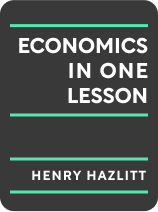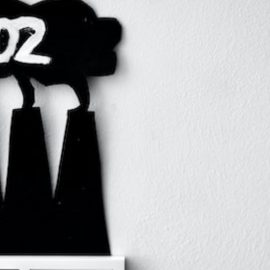

This article is an excerpt from the Shortform book guide to "Economics in One Lesson" by Henry Hazlitt. Shortform has the world's best summaries and analyses of books you should be reading.
Like this article? Sign up for a free trial here .
How do minimum wage laws influence the economy? Are there any negative effects of setting a minimum wage?
The minimum wage is generally seen as a good thing that benefits the workforce. However, according to economist Henry Hazlitt, minimum wage laws actually hurt employment and productivity.
In this article, we’ll take a look at the negative effects of minimum wage laws on the economy at large.
Minimum Wage: The Evil in Disguise
Just as artificially raising prices hurts productivity and employment, raising wages has the same effect. Raising the minimum wage forces companies to do one of two things:
- Companies can raise the prices for their products, in order to pass the burden to consumers. However, higher prices can cause consumers to either buy less or find cheaper or alternative goods, which cuts into companies’ profits and lowers employment and productivity levels.
- Companies can absorb the higher cost of labor without raising prices on their products. In this case, marginal companies will go out of business, leading to unemployment and less overall production. (Shortform note: This point appears contradictory to Hazlitt’s earlier argument that inefficient companies must be allowed to die so that their capital and manpower can go to more efficient businesses, thus increasing production. Presumably, the difference here is that the marginal companies are being put out of business by the artificial force of minimum wage raises, whereas inefficient companies are weeded out by the natural effects of supply and demand.)
Additionally, raising the minimum wage doesn’t raise the value of individual workers. When companies see their profits fall as a result of a minimum wage raise, the workers who are deemed unworthy of the higher wage will become unemployed. Although those workers’ previous wages may have been low, they were presumably the best available—and when the workers lose those jobs, they will be forced to accept work and wages that they had previously considered unacceptable. Furthermore, increased competition further drives down wages for those less desirable jobs. Overall, the long-term effects of minimum wage mandates are actually negative because they end up hurting the workers they aim to help.
The Issues With Unemployment Relief
When minimum wage laws increase unemployment, the government may be tempted to help unemployed workers through relief programs. However, these efforts bring additional consequences.
If the government offers unemployment relief, the payments will likely be less than the workers’ previous wages. If wages were $500 per week before the government raised the minimum wage, and unemployment relief is $400 per week, then the government’s effort to help workers actually pushes many into unemployment and forces them to live off of less income. In the process, consumers also suffer a loss of those workers’ services and contributions to production. (Shortform note: Additionally, research shows that it’s harder to land a job when you’re unemployed, meaning that these workers face a greater challenge in finding a way to earn more than unemployment payments provide.)
Alternatively, if unemployment payments are higher than previous wages—for example, $550 per week—then people are disincentivized from working, which decreases production. Furthermore, if the minimum wage raise lifts paychecks from $500 to $600 per week, workers who are still employed are essentially working to earn $50, since they could make $550 without working.
Instead of unemployment payments, the government may offer work relief programs, which provide unemployed workers with new jobs on government make-work projects. In Chapter 4, we discussed the issues with these job creation projects, such as their inherent inefficiency and the tax burden they place on the public. Additionally, these projects are limited in scope because they must be so simple that they can employ the least-skilled workers—otherwise, if the government were to begin training these workers in more specialized skills, they risk competing with existing industry jobs and upsetting unions.
Raise Wages by Raising Productivity
The problem with raising wages is that the effort tries to distribute wealth that doesn’t exist. In order to truly raise wages, the wealth needs to be created first through increased productivity, which can be achieved through:
- New production innovations
- More labor-saving machines
- Improved training and education for workers
- Improved efficiency among workers
- More efficient management
Union Efforts to Raise Wages Reduces Everyone’s Wages
Fallacy: When a union achieves wage raises for its members, it sets off a ripple effect that raises wages among all workers.
Reality: When one union achieves wage raises for its members, in the long run, it reduces wages for everyone, including union workers in other industries.
Outside of government efforts to raise the minimum wage for all workers, trade unions also push to secure higher wages for their members. In unions’ early years, they achieved better working conditions and shorter work weeks, which increased productivity by improving workers’ health and well-being. However, in recent decades, union efforts to raise wages for its members provide short-term benefits, but, in the long term, they create unemployment, decrease productivity, and lower wages across the board.
When a union raises one trade’s wages above market rates, it indirectly hurts workers in other industries. The companies that hire the union workers are likely to raise the cost of goods in order to cover the wage raises. The price hikes raise the cost of living for everyone—essentially taking more money out of other people’s paychecks—while only those union workers have the increased wages to cover the higher cost of living.
In the long run, raising wages also creates unemployment among the very workers whose incomes are increasing. If a company is forced to absorb the higher cost of labor, it will either go out of business entirely, or it will have to cut jobs. Alternatively, if a company is able to raise its prices in order to shift the cost burden to consumers, sales are likely to fall, which reduces profits and leads to layoffs. Additionally, investors who support the business face a lower return on their investment when labor costs rise, which disincentivizes them from putting any more money toward the company’s future success. As a result, the company is likely to struggle or close entirely, leading to unemployment.
In order to prevent one union from prospering at the expense of all other workers, some union supporters suggest unionizing all workers. There are two potential outcomes of this proposal:
- Realistically, some unions would have more power to achieve greater demands than others, which defeats the effort to put everyone on equal footing. The more powerful unions would likely have larger memberships, make more essential products, or use coercive methods of accomplishing demands.
- If all unions managed to have equal power and achieve equal wage increases, then incomes and cost of living would rise proportionately and everyone would ultimately be no better off than they were initially.
Set Wages to Support Maximum Employment
Fallacy: Wages should be set high enough that workers can buy the products they help create.
Reality: Wages should be set to support the highest level of employment and largest total payrolls possible.
When unions push for fair wages, there is no universal standard for what is considered fair. Classical economists promote functional wages supported by functional prices. In that school of thought, functional wages enable the highest level of employment and largest payrolls possible, and functional prices support the highest levels of production and sales. Still, there is no calculation for determining the most functional wages—and, in its place, unions call for workers to earn enough to purchase the product they help create.
This benchmark calls into question the goal of having each worker make enough to buy back the specific product she creates. If so, there will be a major discrepancy between the wages of workers who make socks and workers who make mink coats. Additionally, workers from many industries contribute to the production of a single product—for example, clothes aren’t made just by the workers who sew them, but also by the workers who mill the cotton, weave the fabric, and assemble the sewing machines.
These questions aside, any wage raise requires producers to find a way to pay for the higher cost of labor, presumably through raising prices on their products. However, as we’ve discussed, unless higher wages are supported by higher productivity, they ultimately lead to unemployment. This result not only hurts workers’ purchasing power, but also lowers the production of goods for everyone to enjoy, which means that the nation is poorer overall.
Rather than aiming for an ambiguous goal of having workers earn enough to buy back the products they create, wages and prices should be set based on supply and demand.

———End of Preview———
Like what you just read? Read the rest of the world's best book summary and analysis of Henry Hazlitt's "Economics in One Lesson" at Shortform .
Here's what you'll find in our full Economics in One Lesson summary :
- A clear, concise explanation of the secondary consequences of a range of economic policies
- How labor-saving technology actually creates more jobs
- How saving money supports the economy more than spending it






